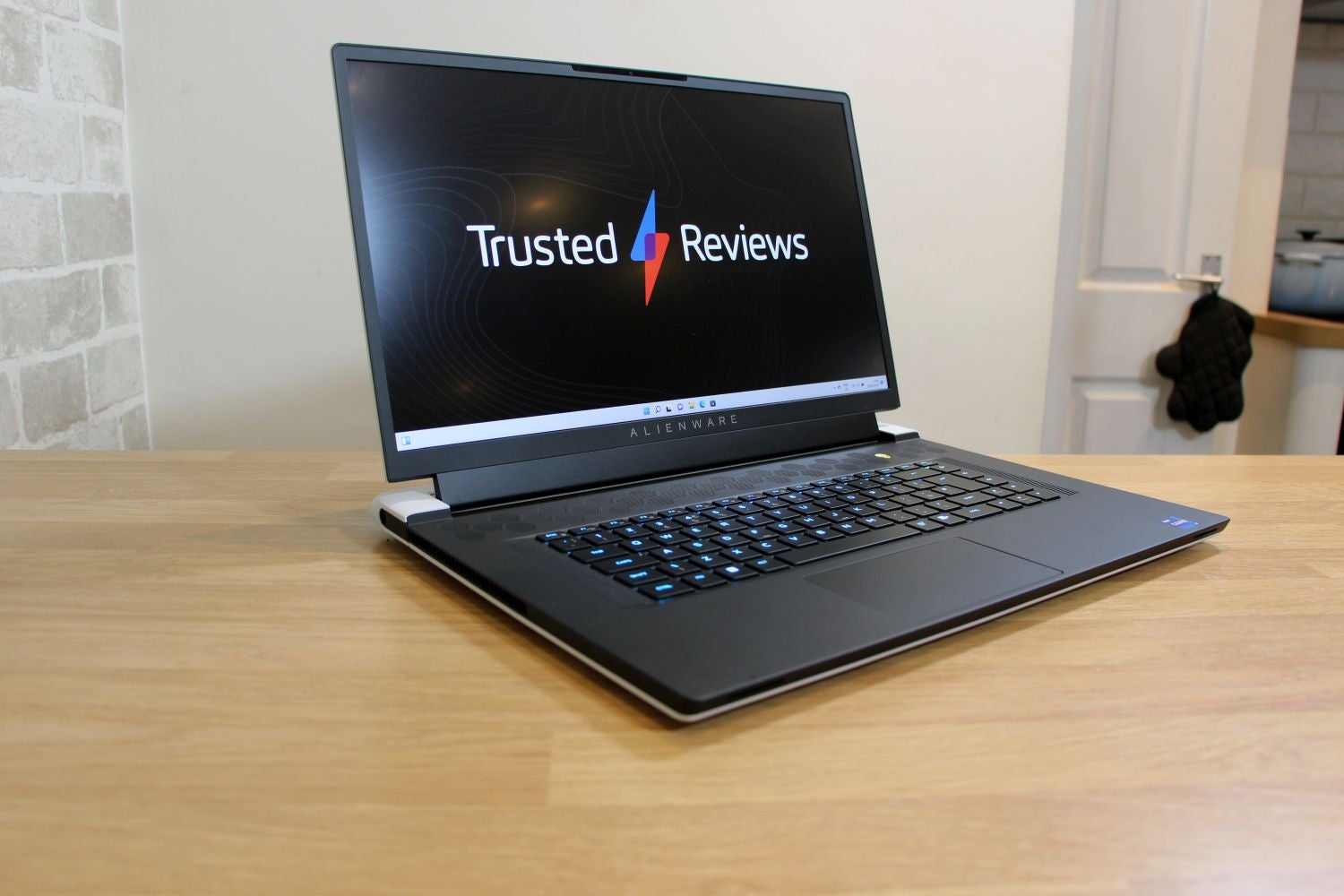Verdict
The Alienware x17 R2 delivers stunning gaming and processing speeds, a top-notch screen and a sturdy, good-looking chassis, and it’s only hindered by an expected high price and unsurprisingly poor battery life. It’s one of the best 17.3in gaming notebooks on the market today.
Pros
- Sensational gaming and CPU speeds
- Top-quality 360Hz screen
- Crisp, satisfying keyboard
- Good connectivity
Cons
- Expensive
- Poor battery life
- Underwhelming overclocking
Availability
- UKRRP: £3148
- USARRP: $3499
- EuropeRRP: €3848
-
Superb RTX 3080 Ti graphics core and Intel processorThe Nvidia GeForce RTX 3080 Ti runs at a stonking 175W to deliver incredible gaming speeds, and the i7-12700H is one of the best laptop processors around today. -
A rapid 360Hz displayThe 17.3in has a 360Hz refresh rate with Nvidia G-Sync, so it’s well suited to eSports, and quality levels are impressive too. -
High-quality Alienware designAlienware machines always look the part, and the x17 has impressive build quality and a satisfying keyboard.
Introduction
The Alienware x17 is the brand’s largest gaming laptop, and this supersized notebook combines Alienware’s familiar design with incredible components.
On the outside the x17 serves up its stunning, monochrome Legend 2.0 aesthetic, on the inside it’s got an Nvidia GeForce RTX 3080 Ti alongside an Intel Alder Lake processor and a 360Hz display.
Alienware laptops are rarely cheap, though, and the model I’ve reviewed costs £3149 / $3499 / €3849, and you’ll still have to pay £2149 / $2249 / €2399 for even the entry-level model.
The Alienware x17 is impressive but expensive – can it possibly be worth it?
Design and Keyboard
- Superb, sturdy and good-looking exterior
- Plenty of ports, although they’re tricky to see thanks to RGB LEDs
- An excellent keyboard, and a mechanical upgrade is available
There’s no denying that Alienware leads the market for high-end gaming laptop design. The black and white exterior is good looking and has impeccable build quality; the RGB LED logos and honeycomb vents all look excellent.
The Alienware x17 R2 is 21mm thick, which is decent for a large and powerful notebook – that figure sits between the slimmer Razer Blade 17 and the thicker Asus ROG Strix Scar 17, which are the x17’s main rivals. Bear in mind, though, that the x17 weighs 3kg and is heavier than both.
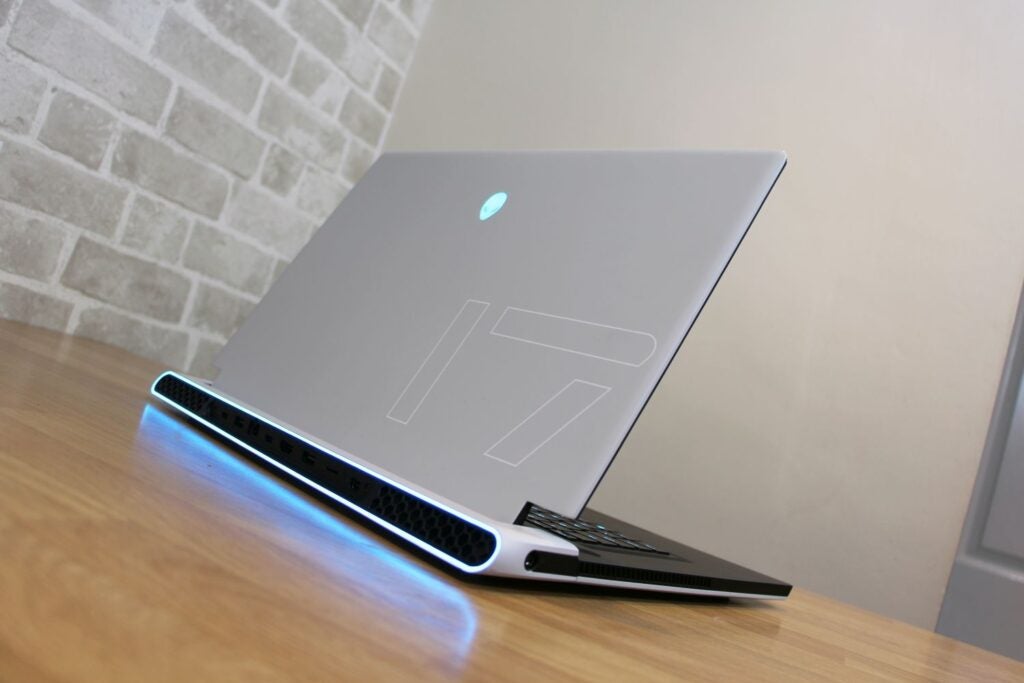
The x17 – like the smaller x15 – has all its ports along the back edge. While that makes cabling neater, it also means the ports are trickier to reach when compared to side-mounted sockets, and the ring of bright RGB LEDs makes them difficult to see.
Get past that light and you’ll find one Thunderbolt 4 port, a USB 3.2 Gen 2 Type-C port with power delivery, and two USB 3.2 Gen 1 connectors. The x17 also has a future-proofed HDMI 2.1 output, a microSD slot and a mini-DisplayPort socket, and internal connectivity comes from dual-band Wi-Fi 6 and Gigabit Ethernet.
The Alienware’s 720p webcam supports Windows Hello, but the x17 misses a fingerprint reader.
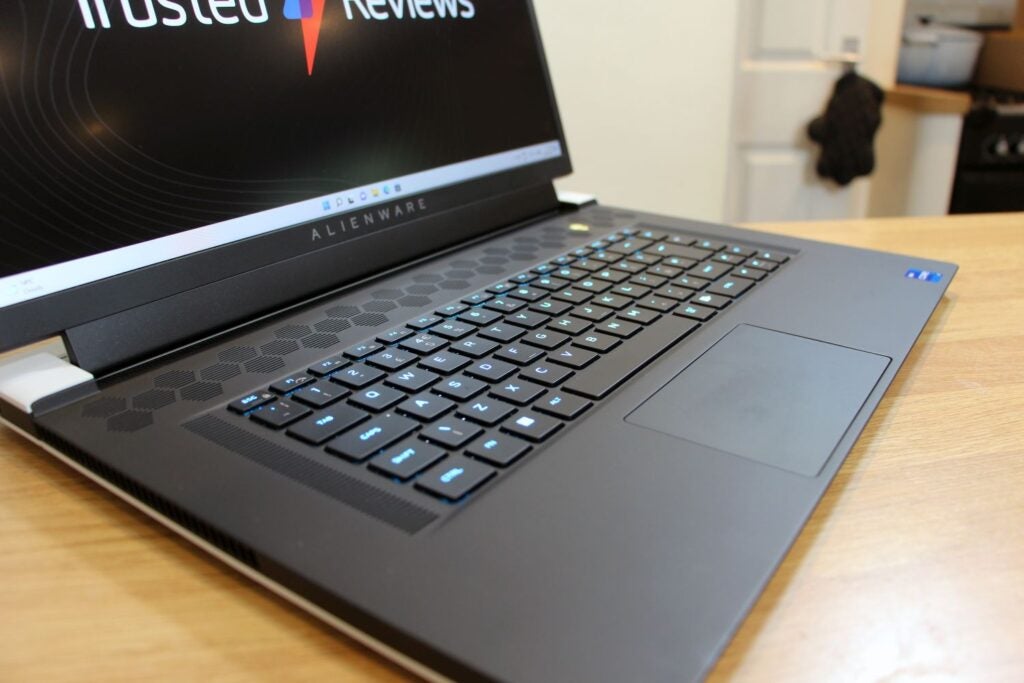
Open the Alienware x17 R2 and you’ll find a per-key RGB LED keyboard with N-key rollover, anti-ghosting and 1.5mm of travel. There’s an extra column of media keys on the right-hand edge, but there’s no numberpad.
It’s an excellent keyboard. The buttons are fast and crisp, with snappy movement reminiscent of low-profile mechanical hardware, and it’s preferable to Razer’s shallower gear.
As usual, the x17 can be upgraded with CherryMX mechanical hardware that offers even more speed and weight, but the Alienware’s standard unit is easily good enough for hardcore gamers.
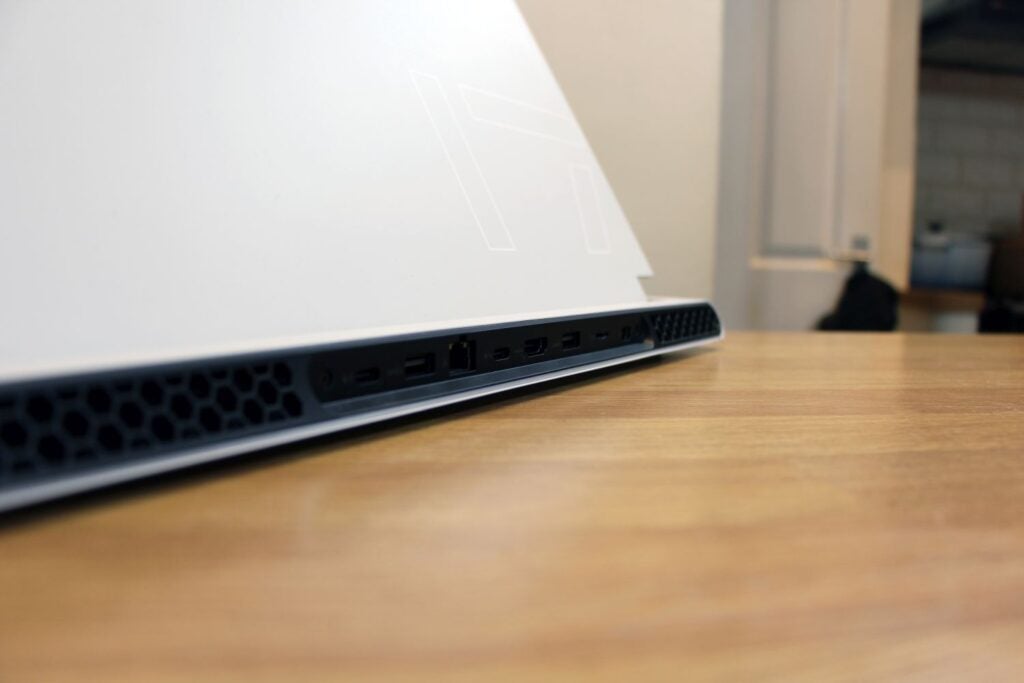
If you do want to upgrade, check the prices. It’s $150 extra in the US, which is reasonable, but at the time of writing it’s €300 in Europe and a whopping £600 in the UK – too much for any mechanical keyboard.
The trackpad is fine, if unsurprising, but anyone who wants to enjoy gaming will be using a USB peripheral. The speakers are fine, too: bassy and loud, albeit with a tinny top-end. They’re serviceable for gaming but a headset would be far better.
Screen
- A smooth and high-quality 360Hz screen
- 4K and cheaper 1080p options are available
- The x17’s 1ms response time means it’s even better for eSports
The Alienware x17 I’ve reviewed has a 1080p IPS panel with a 360Hz refresh rate and 1ms response time, and it’s stunning. The refresh rate pairs with Nvidia G-Sync to provide butter-smooth animation, and that means it’s suitable for top-tier eSports. It’s also a bit better than the Asus and Razer machines, which have 3ms response times.
The smooth, crisp gaming output is bolstered by great quality. The 1,153:1 contrast ratio ensures plenty of punch, and the delta E of 1.78 means colours are accurate. The screen renders 98.1% of the sRGB gamut, so it produces every shade needed by mainstream games.
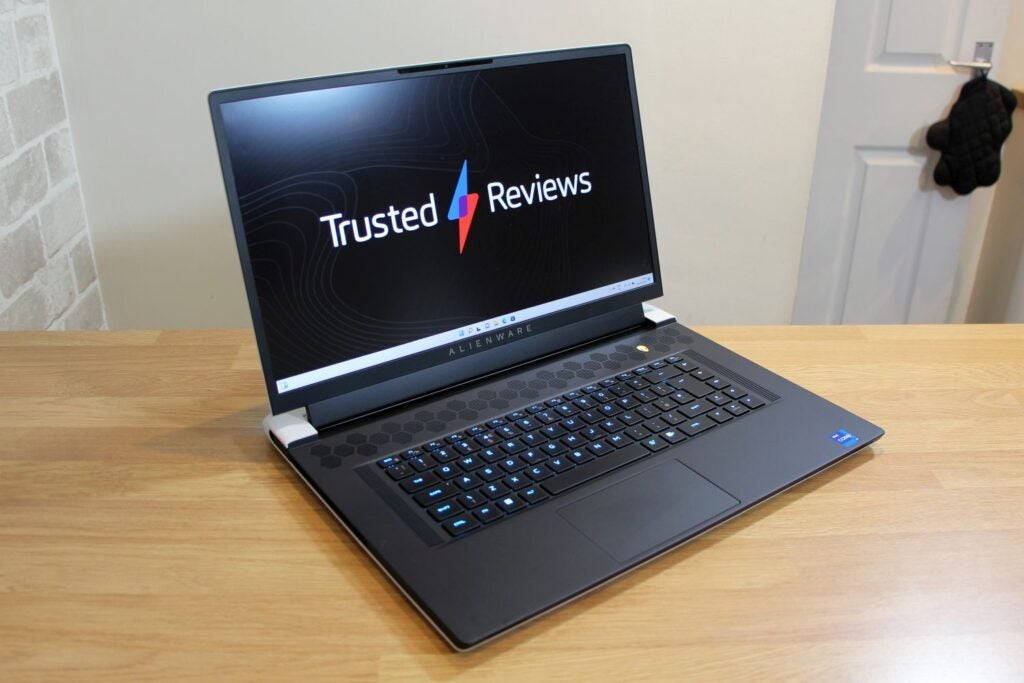
There are no big issues. The panel can’t render more than 80% of the Adobe and DCI-P3 gamuts, so it’s not suitable for content creators, and it could be a little brighter – it’s fine indoors, but it’ll struggle in unobstructed sunlight.
It’s also a shame that Dell doesn’t have more upgrade options. Buyers can save £250 / $100 / €250 on a Full HD screen at 165Hz, and single-player gamers can spend £650 / $200 / €350 on a 4K/120Hz panel, but there are no 2560 x 1440 or 240Hz panels available. You’ll find both on the Asus and Razer notebooks if you’d like that middle ground.
Performance
- Consistently brilliant speeds in games and application benchmarks
- A surprisingly good thermal performer considering the hardware inside
- The x17 is not cheap, but it offers decent value compared to rivals
This high-end Alienware x17 R2 has an Nvidia GeForce RTX 3080 Ti graphics core with 16GB of memory and a monster 175W power limit. A 20-thread Intel Core i7-12700H joins this mighty GPU, 32GB of DDR5 memory and a 1TB SSD with sensational read and write speeds of 6318MB/sec and 4155MB/sec. If you want to upgrade, the base is easily removable and the x17 has pairs of memory and M.2 SSD sockets.
It’s a recipe for incredible performance. The x17 romped through Horizon Zero Dawn at Ultimate settings at 120fps, which is 24fps better than the RTX 3080 and the same distance ahead of the RTX 3070 Ti laptop core. The x17 maintained a similarly wide gap in Borderlands 3, and its 226fps average in Rainbow Six Siege is 31fps ahead of the RTX 3070 Ti.
There aren’t many games this laptop won’t play. It’ll scythe through every high-end single-player game, no matter its demands. Ray tracing and DLSS won’t be a problem. The x17 never struggles with eSports titles; most are less demanding than Rainbow Six, so hitting 360fps won’t be an issue.
| Alienware x17 R2 | Alienware x15 R2 | Asus ROG Strix Scar 15 | |
| CPU | Intel Core i7-12700H | Intel Core i9-11900H | Intel Core i9-12900H |
| PCMark10 | 7856 | 6780 | 7705 |
| Geekbench 5 Single / Multi | 1686 / 12,040 | 1610 / 9369 | 1658 / 9680 |
| GPU | Nvidia RTX 3080 Ti | Nvidia RTX 3070 | Nvidia RTX 3070 Ti |
| 3DMark Time Spy | 12,486 | 9751 | 10,389 |
The only disappointing note right now is the Alienware x17 R2’s overclocking performance. The Alienware ostensibly has two overclocking modes, but neither improved gaming speeds. Indeed, the machine’s superb 3D Mark Time Spy result of 12,486 dropped slightly to 12,434. I can only hope Dell improves this feature with firmware and software updates.
Those overclocked modes didn’t boost CPU performance, either, but the i7-12700H doesn’t need any help there. In Geekbench’s single- and multi-core tests the fourteen-core chip delivered scores of 1686 and 12,040, with the latter significantly faster than the Core i7-12800H and i9-11900H used in many other laptops. It’s also quicker than the AMD Ryzen 7 6800H and Ryzen 9 6900HX that are available in the thicker, heavier m17, and there’s hardly any price difference between the two.
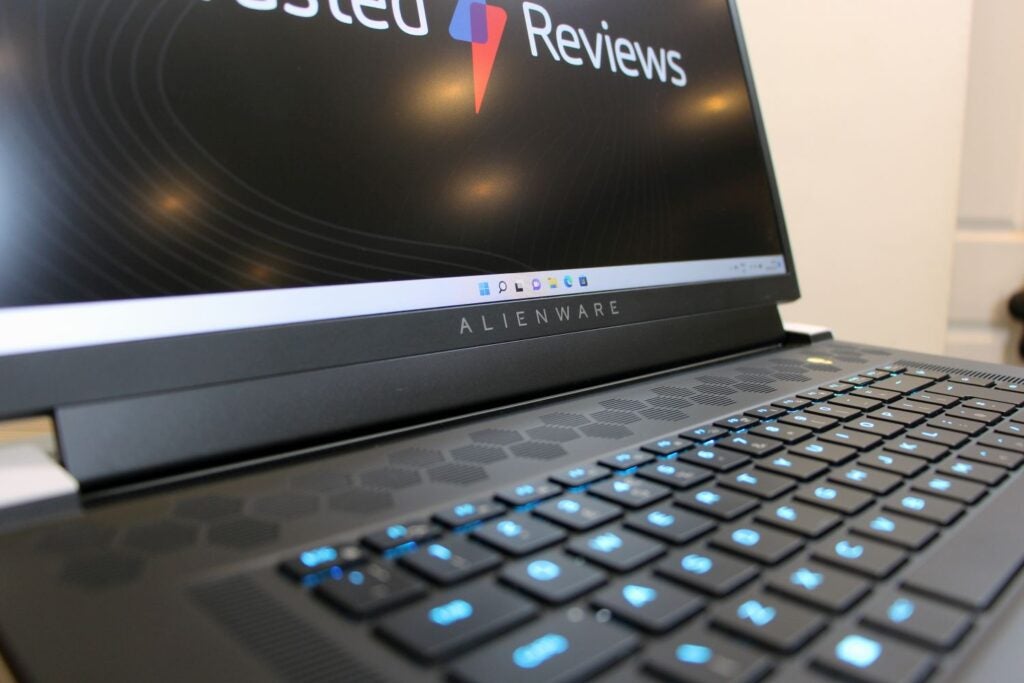
That Core i7 chip will handle virtually anything, from demanding content-creation apps to intense multi-tasking, and you’ll only need to pay for the Core i9 if you want every drop of processing power. The lofty performance is testament to the x17’s impressive cooling, and indicates that the CPU isn’t hindered as badly by throttling evident on smaller notebooks.
The x17 performs reasonably well in most thermal tests. The x17’s fan noise is present during normal gaming situations, but it’s modest – certainly quieter than most other high-end gaming notebooks. And while the area above the keyboard does become extremely toasty, the rest of the machine is warm rather than annoyingly hot.
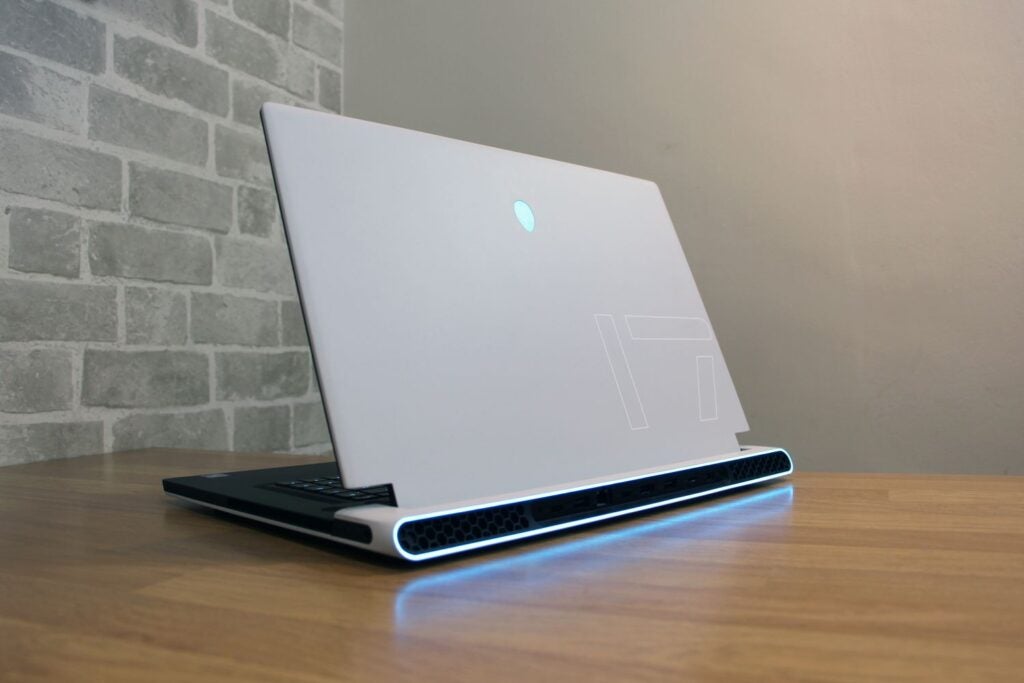
There’s no doubt that the x17 is impressive, but it’s pretty expensive too. An Asus ROG Strix Scar 17 at this level uses a 240Hz, QHD display and Core i9-12900H, and it costs £3399 / $3212 / €3737 – and in some markets you get a backpack, headset and mouse in the box.
If you look at other brands that offer 17.3in, 360Hz displays with RTX 3080 Ti graphics you’ll save a little more. The only pricier rival is the Razer, which costs £4099 / $3999 / €4299 for equivalent hardware.
Surprisingly, though, the x17 is reasonably good value when compared to the x15. For an equivalent specification it’ll cost you £3349 / $3399 / €3949, and it doesn’t have a CherryMX keyboard upgrade option.
Battery life
- You’ll only get an hour of gaming from this notebook
- Don’t expect even half a day’s use in work or media scenarios either
As ever, don’t expect this large machine to last long away from the mains. You’ll get about an hour of lifespan from the battery while gaming, and that’s with reduced graphical power.
The Alienware x17 R2 lasted for 2hrs 13mins in a work test with the screen at 150 nits, which is a poor result even among gaming notebooks, and it played video for 3hrs 46mins. This, even more than most gaming machines, is a laptop that relies on a mains connection.
Latest deals
Should you buy it?
You want top speeds and a big laptop
Alienware’s x17 R2 has incredible gaming and application pace inside a sturdy, good-looking chassis – with a great screen and keyboard. It’s an eye-catching, market-leading laptop.
You’d prefer something smaller or more subtle, or a laptop with better battery life
The Alienware is not a shy and retiring notebook, and its sheer size and power means it doesn’t last long away from a plug.
Final Thoughts
The Alienware x17 R2 delivers sensational speed, great design, a top-notch screen and good connectivity alongside a solid keyboard, so it’s one of the best large gaming laptops around anywhere – although be aware of its high price, low battery life and its potentially cheaper rivals.
How we test
Every gaming laptop we review goes through a series of uniform checks designed to gauge key things including build quality, performance, screen quality and battery life.
These include formal synthetic benchmarks and scripted tests, plus a series of real world checks, such as how well it runs when running a AAA game.
We used as our main laptop for at least a week.
Tested the performance via both benchmark tests and real-world use.
We tested the screen with a colorimeter and real-world use.
We tested the battery with a benchmark test and real-world use.
FAQs
Yes, although the main 330W power brick delivers far more juice at a greater speed.
Trusted Reviews test data
Horizon Zero Dawn frame rate (Full HD)
Dirt Rally (Full HD)
Borderlands 3 frame rate (Full HD)
PCMark Battery (office)
Brightness
CrystalMarkDisk Write Speed
CrystalDiskMark Read speed
3DMark Time Spy
Geekbench 5 multi core
Geekbench 5 single core
Contrast
Black level
White Visual Colour Temperature
sRGB
Adobe RGB
DCI-P3
Battery Life
PCMark Battery (gaming)
PCMark 10
UK RRP
USA RRP
EU RRP
CPU
Manufacturer
Screen Size
Storage Capacity
Front Camera
Battery
Battery Hours
Size (Dimensions)
Weight
Operating System
Release Date
First Reviewed Date
Resolution
Refresh Rate
Ports
Audio (Power output)
GPU
RAM
Connectivity
Colours
Display Technology
Screen Technology
Touch Screen
Convertible?
Jargon buster
Refresh Rate
The number of times the screen refreshes itself per second.
Verdict
The Alienware x17 R2 delivers stunning gaming and processing speeds, a top-notch screen and a sturdy, good-looking chassis, and it’s only hindered by an expected high price and unsurprisingly poor battery life. It’s one of the best 17.3in gaming notebooks on the market today.
Pros
- Sensational gaming and CPU speeds
- Top-quality 360Hz screen
- Crisp, satisfying keyboard
- Good connectivity
Cons
- Expensive
- Poor battery life
- Underwhelming overclocking
Availability
- UKRRP: £3148
- USARRP: $3499
- EuropeRRP: €3848
-
Superb RTX 3080 Ti graphics core and Intel processorThe Nvidia GeForce RTX 3080 Ti runs at a stonking 175W to deliver incredible gaming speeds, and the i7-12700H is one of the best laptop processors around today. -
A rapid 360Hz displayThe 17.3in has a 360Hz refresh rate with Nvidia G-Sync, so it’s well suited to eSports, and quality levels are impressive too. -
High-quality Alienware designAlienware machines always look the part, and the x17 has impressive build quality and a satisfying keyboard.
Introduction
The Alienware x17 is the brand’s largest gaming laptop, and this supersized notebook combines Alienware’s familiar design with incredible components.
On the outside the x17 serves up its stunning, monochrome Legend 2.0 aesthetic, on the inside it’s got an Nvidia GeForce RTX 3080 Ti alongside an Intel Alder Lake processor and a 360Hz display.
Alienware laptops are rarely cheap, though, and the model I’ve reviewed costs £3149 / $3499 / €3849, and you’ll still have to pay £2149 / $2249 / €2399 for even the entry-level model.
The Alienware x17 is impressive but expensive – can it possibly be worth it?
Design and Keyboard
- Superb, sturdy and good-looking exterior
- Plenty of ports, although they’re tricky to see thanks to RGB LEDs
- An excellent keyboard, and a mechanical upgrade is available
There’s no denying that Alienware leads the market for high-end gaming laptop design. The black and white exterior is good looking and has impeccable build quality; the RGB LED logos and honeycomb vents all look excellent.
The Alienware x17 R2 is 21mm thick, which is decent for a large and powerful notebook – that figure sits between the slimmer Razer Blade 17 and the thicker Asus ROG Strix Scar 17, which are the x17’s main rivals. Bear in mind, though, that the x17 weighs 3kg and is heavier than both.

The x17 – like the smaller x15 – has all its ports along the back edge. While that makes cabling neater, it also means the ports are trickier to reach when compared to side-mounted sockets, and the ring of bright RGB LEDs makes them difficult to see.
Get past that light and you’ll find one Thunderbolt 4 port, a USB 3.2 Gen 2 Type-C port with power delivery, and two USB 3.2 Gen 1 connectors. The x17 also has a future-proofed HDMI 2.1 output, a microSD slot and a mini-DisplayPort socket, and internal connectivity comes from dual-band Wi-Fi 6 and Gigabit Ethernet.
The Alienware’s 720p webcam supports Windows Hello, but the x17 misses a fingerprint reader.

Open the Alienware x17 R2 and you’ll find a per-key RGB LED keyboard with N-key rollover, anti-ghosting and 1.5mm of travel. There’s an extra column of media keys on the right-hand edge, but there’s no numberpad.
It’s an excellent keyboard. The buttons are fast and crisp, with snappy movement reminiscent of low-profile mechanical hardware, and it’s preferable to Razer’s shallower gear.
As usual, the x17 can be upgraded with CherryMX mechanical hardware that offers even more speed and weight, but the Alienware’s standard unit is easily good enough for hardcore gamers.

If you do want to upgrade, check the prices. It’s $150 extra in the US, which is reasonable, but at the time of writing it’s €300 in Europe and a whopping £600 in the UK – too much for any mechanical keyboard.
The trackpad is fine, if unsurprising, but anyone who wants to enjoy gaming will be using a USB peripheral. The speakers are fine, too: bassy and loud, albeit with a tinny top-end. They’re serviceable for gaming but a headset would be far better.
Screen
- A smooth and high-quality 360Hz screen
- 4K and cheaper 1080p options are available
- The x17’s 1ms response time means it’s even better for eSports
The Alienware x17 I’ve reviewed has a 1080p IPS panel with a 360Hz refresh rate and 1ms response time, and it’s stunning. The refresh rate pairs with Nvidia G-Sync to provide butter-smooth animation, and that means it’s suitable for top-tier eSports. It’s also a bit better than the Asus and Razer machines, which have 3ms response times.
The smooth, crisp gaming output is bolstered by great quality. The 1,153:1 contrast ratio ensures plenty of punch, and the delta E of 1.78 means colours are accurate. The screen renders 98.1% of the sRGB gamut, so it produces every shade needed by mainstream games.

There are no big issues. The panel can’t render more than 80% of the Adobe and DCI-P3 gamuts, so it’s not suitable for content creators, and it could be a little brighter – it’s fine indoors, but it’ll struggle in unobstructed sunlight.
It’s also a shame that Dell doesn’t have more upgrade options. Buyers can save £250 / $100 / €250 on a Full HD screen at 165Hz, and single-player gamers can spend £650 / $200 / €350 on a 4K/120Hz panel, but there are no 2560 x 1440 or 240Hz panels available. You’ll find both on the Asus and Razer notebooks if you’d like that middle ground.
Performance
- Consistently brilliant speeds in games and application benchmarks
- A surprisingly good thermal performer considering the hardware inside
- The x17 is not cheap, but it offers decent value compared to rivals
This high-end Alienware x17 R2 has an Nvidia GeForce RTX 3080 Ti graphics core with 16GB of memory and a monster 175W power limit. A 20-thread Intel Core i7-12700H joins this mighty GPU, 32GB of DDR5 memory and a 1TB SSD with sensational read and write speeds of 6318MB/sec and 4155MB/sec. If you want to upgrade, the base is easily removable and the x17 has pairs of memory and M.2 SSD sockets.
It’s a recipe for incredible performance. The x17 romped through Horizon Zero Dawn at Ultimate settings at 120fps, which is 24fps better than the RTX 3080 and the same distance ahead of the RTX 3070 Ti laptop core. The x17 maintained a similarly wide gap in Borderlands 3, and its 226fps average in Rainbow Six Siege is 31fps ahead of the RTX 3070 Ti.
There aren’t many games this laptop won’t play. It’ll scythe through every high-end single-player game, no matter its demands. Ray tracing and DLSS won’t be a problem. The x17 never struggles with eSports titles; most are less demanding than Rainbow Six, so hitting 360fps won’t be an issue.
| Alienware x17 R2 | Alienware x15 R2 | Asus ROG Strix Scar 15 | |
| CPU | Intel Core i7-12700H | Intel Core i9-11900H | Intel Core i9-12900H |
| PCMark10 | 7856 | 6780 | 7705 |
| Geekbench 5 Single / Multi | 1686 / 12,040 | 1610 / 9369 | 1658 / 9680 |
| GPU | Nvidia RTX 3080 Ti | Nvidia RTX 3070 | Nvidia RTX 3070 Ti |
| 3DMark Time Spy | 12,486 | 9751 | 10,389 |
The only disappointing note right now is the Alienware x17 R2’s overclocking performance. The Alienware ostensibly has two overclocking modes, but neither improved gaming speeds. Indeed, the machine’s superb 3D Mark Time Spy result of 12,486 dropped slightly to 12,434. I can only hope Dell improves this feature with firmware and software updates.
Those overclocked modes didn’t boost CPU performance, either, but the i7-12700H doesn’t need any help there. In Geekbench’s single- and multi-core tests the fourteen-core chip delivered scores of 1686 and 12,040, with the latter significantly faster than the Core i7-12800H and i9-11900H used in many other laptops. It’s also quicker than the AMD Ryzen 7 6800H and Ryzen 9 6900HX that are available in the thicker, heavier m17, and there’s hardly any price difference between the two.

That Core i7 chip will handle virtually anything, from demanding content-creation apps to intense multi-tasking, and you’ll only need to pay for the Core i9 if you want every drop of processing power. The lofty performance is testament to the x17’s impressive cooling, and indicates that the CPU isn’t hindered as badly by throttling evident on smaller notebooks.
The x17 performs reasonably well in most thermal tests. The x17’s fan noise is present during normal gaming situations, but it’s modest – certainly quieter than most other high-end gaming notebooks. And while the area above the keyboard does become extremely toasty, the rest of the machine is warm rather than annoyingly hot.

There’s no doubt that the x17 is impressive, but it’s pretty expensive too. An Asus ROG Strix Scar 17 at this level uses a 240Hz, QHD display and Core i9-12900H, and it costs £3399 / $3212 / €3737 – and in some markets you get a backpack, headset and mouse in the box.
If you look at other brands that offer 17.3in, 360Hz displays with RTX 3080 Ti graphics you’ll save a little more. The only pricier rival is the Razer, which costs £4099 / $3999 / €4299 for equivalent hardware.
Surprisingly, though, the x17 is reasonably good value when compared to the x15. For an equivalent specification it’ll cost you £3349 / $3399 / €3949, and it doesn’t have a CherryMX keyboard upgrade option.
Battery life
- You’ll only get an hour of gaming from this notebook
- Don’t expect even half a day’s use in work or media scenarios either
As ever, don’t expect this large machine to last long away from the mains. You’ll get about an hour of lifespan from the battery while gaming, and that’s with reduced graphical power.
The Alienware x17 R2 lasted for 2hrs 13mins in a work test with the screen at 150 nits, which is a poor result even among gaming notebooks, and it played video for 3hrs 46mins. This, even more than most gaming machines, is a laptop that relies on a mains connection.
Latest deals
Should you buy it?
You want top speeds and a big laptop
Alienware’s x17 R2 has incredible gaming and application pace inside a sturdy, good-looking chassis – with a great screen and keyboard. It’s an eye-catching, market-leading laptop.
You’d prefer something smaller or more subtle, or a laptop with better battery life
The Alienware is not a shy and retiring notebook, and its sheer size and power means it doesn’t last long away from a plug.
Final Thoughts
The Alienware x17 R2 delivers sensational speed, great design, a top-notch screen and good connectivity alongside a solid keyboard, so it’s one of the best large gaming laptops around anywhere – although be aware of its high price, low battery life and its potentially cheaper rivals.
How we test
Every gaming laptop we review goes through a series of uniform checks designed to gauge key things including build quality, performance, screen quality and battery life.
These include formal synthetic benchmarks and scripted tests, plus a series of real world checks, such as how well it runs when running a AAA game.
We used as our main laptop for at least a week.
Tested the performance via both benchmark tests and real-world use.
We tested the screen with a colorimeter and real-world use.
We tested the battery with a benchmark test and real-world use.
FAQs
Yes, although the main 330W power brick delivers far more juice at a greater speed.
Trusted Reviews test data
Horizon Zero Dawn frame rate (Full HD)
Dirt Rally (Full HD)
Borderlands 3 frame rate (Full HD)
PCMark Battery (office)
Brightness
CrystalMarkDisk Write Speed
CrystalDiskMark Read speed
3DMark Time Spy
Geekbench 5 multi core
Geekbench 5 single core
Contrast
Black level
White Visual Colour Temperature
sRGB
Adobe RGB
DCI-P3
Battery Life
PCMark Battery (gaming)
PCMark 10
UK RRP
USA RRP
EU RRP
CPU
Manufacturer
Screen Size
Storage Capacity
Front Camera
Battery
Battery Hours
Size (Dimensions)
Weight
Operating System
Release Date
First Reviewed Date
Resolution
Refresh Rate
Ports
Audio (Power output)
GPU
RAM
Connectivity
Colours
Display Technology
Screen Technology
Touch Screen
Convertible?
Jargon buster
Refresh Rate
The number of times the screen refreshes itself per second.



















